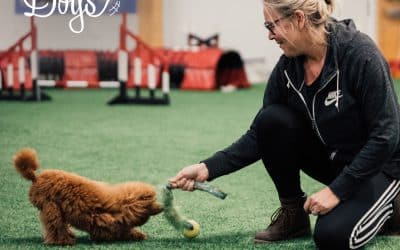Are you worried every time you let your dog off the leash at the park? Or every time the front door opens and your dog inches closer to the exit? You might think that if they run off, that’s it. They’ll never come back no matter how many times you call them. Or they’ll harass other dogs or people, chase wildlife and who knows what else before finally coming back.
We know how stressful that feeling can be, and we’ve got just the solution for you: our recall challenge!
The word “Recall” basically means having your dog come when called. At OneMind Dogs, we believe that having a well-behaved dog comes from understanding their perspective and working with them rather than against them. Our recall challenge is designed to help you learn how to better understand your dog and get them to come running back to you.
What Is the Recall Challenge?
Our Recall Challenge is a fun and simple way to learn the basic principles of the OneMind Dogs training method. With this approach, we teach you how to better understand your dog’s perspective by learning their body language and communicating more efficiently with them. We’ll also provide tips and tricks for introducing your dog to new places and getting them to come when you call them, no matter the distraction!
Through a curated email series, we’ll provide step-by-step guidance on creating a strong recall. Signing up is quick and easy, so you can get started today.
Mind Your tone when calling your dog
Most of us have memories of our parents yelling our names when we were kids. And we all remember the clear difference between “Come down for dinner” and “Come down here right now!” The same goes for our canine friends.
When you call your dog, be mindful of your tone of voice. Channel your inner cheerleader and use a happy, upbeat tone that says “I’m so excited to see you!” This inviting and friendly tone will make your dog more eager to come to you as they expect good things when they get there.
Remember, dogs are excellent at picking up on our emotions. So, if you’re feeling frustrated or annoyed, take a moment to reset before calling your dog. A grumpy tone might give your dog the impression that they’re in trouble, making them think twice about coming to you.
Recall training is for life!
Practice makes perfect, and the same goes for teaching recall. Consistent practice helps your dog understand and attach value to the recall command. As such, it’s essential to rehearse frequently and reward generously. While your dog is learning you want to be practicing recall at least 10 times daily. As they become more competent with coming when called, you can fade that to a few times per week.
Spread the training sessions throughout the day, incorporating them into your daily routine, such as during walks, playtime, or mealtime. The more opportunities you create for your dog to respond to the recall command and get rewarded for complying, the more reliable their response will become.
Engage your dog’s prey drive
Dogs have a natural prey drive; you can use this to your advantage when teaching recall. When you call your dog, try running away from them. This will get their attention and peak their interest, making them more likely to come to you. Be sure to praise and reward your dog when they catch up to you, you don’t have to use food rewards every time — play together, give them a good belly rub and tell them how good they are. The more your dog values the reward, the stronger their recall will be.
Over time, they will associate coming when called with a positive experience, further reinforcing the behavior.
Switch up the location and distraction level
Practice in different locations to ensure your dog responds to the recall command in various situations. Aim for at least ten recall exercises in different environments, such as your home, backyard, parks, and other public spaces. This variety will help your dog generalize the command and understand that coming to you is always a top priority, no matter where they are.
Use a long lead when training recall
In the beginning stages of training especially, use a long lead to help your dog understand and succeed in the concept of coming when called. If they don’t come when called (only call them one time!) then you can gently reel them in and say “yes” and reward as soon as they look at you. You’ll only have to do this a few times before they start responding straight away. Make the lead a fun experience for your dog by praising and rewarding them when they put it on and never use it to correct the dog.
Offer their favorite rewards
Who doesn’t love a good treat? Just like us, our furry friends can’t resist their favorite snacks. When teaching recall, use high-value treats that your dog goes crazy for. This will make it more enticing for them to come to you when called, especially at the beginning. Remember to give the treat as soon as your dog comes to you, so they make the connection between the command and the reward. There’s no need to ask them to sit first.
If your dog is not into treats, a high-value toy or a fun game with you is a great reward too! Let your dog guide you by offering a variety of rewards and seeing what they value the most.
Test coming when called under distraction
Our world is full of distractions, and your dog must learn to come when called despite them. As your dog becomes more reliable in their recall response, gradually introduce distractions, such as other dogs, people, or even their favorite toy. This will help to strengthen their recall even in challenging situations. Use the long lead any time you introduce a new distraction, to help your dog succeed.
Learning is infinite
Training is an ongoing process, and it’s essential to reinforce various behaviors throughout your dog’s life. Regular practice and sporadic rewarding will ensure that your dog continues to respond reliably, and it’s also an excellent way to bond with your best friend. At OneMind Dogs, we also have super simple Foundation for Agility exercises that you can add to your walks, to further reinforce the bond between you and your pup while also having a lot of fun together.
Common mistakes to avoid
Although recall is a fundamental training command for all dogs, some mistakes can cause confusion and make it more difficult for them to learn.
- Tricking: Avoid tricking your dog into coming to you. For example, don’t pretend to have a treat when you don’t. That can create mistrust, making your dog less likely to respond to your command.
- Aggressive or frustrated behavior: Don’t dive towards your dog or exhibit aggressive behavior once they get close. It can create fear, and your dog may become hesitant to come to you when called. Instead, be gentle and praise them when they approach you. This way, they’ll associate coming to you with positive experiences and feel more comfortable responding to your command.
- Associating their Name with fun ending: Avoid associating your dog’s name with putting them on a lead every time. If you consistently call your dog and immediately put them on a lead, they may start to think that coming when called means the fun is over. To avoid this, practice recall without always putting them on a lead. Keep it fun and unpredictable!
Get started and build a reliable recall
Now that you know the tips and tricks for teaching your dog to come when called, it’s time to get started! Remember, patience and consistency are key. Be prepared for some setbacks along the way, but don’t let that discourage you. Keep things fun and engaging for both you and your dog.
With time, effort, and positive reinforcement, your furry friend will soon respond to your call like a champ!
By participating in the Recall Challenge, you and your dog will have a blast while reinforcing this essential skill. Get started today by filling out the form below to receive exclusive tips, videos and challenges from our experts!



